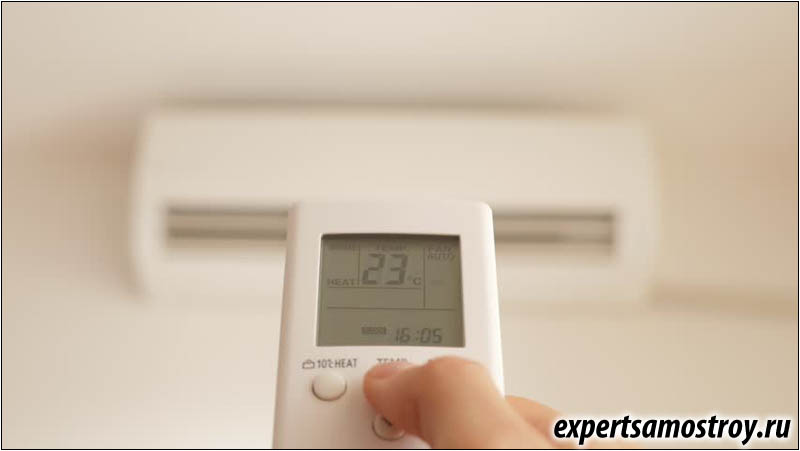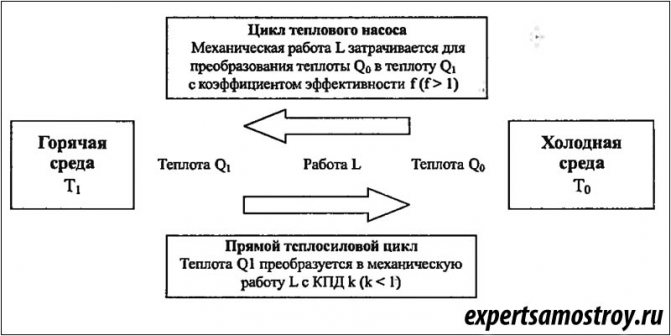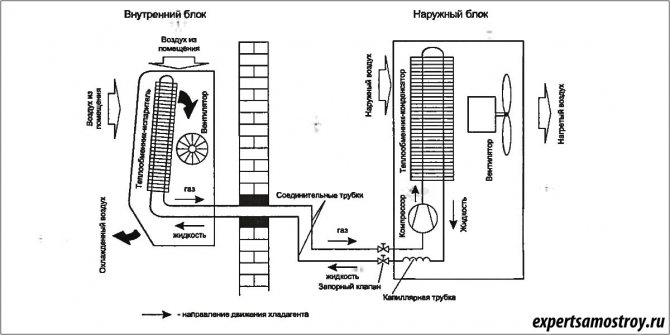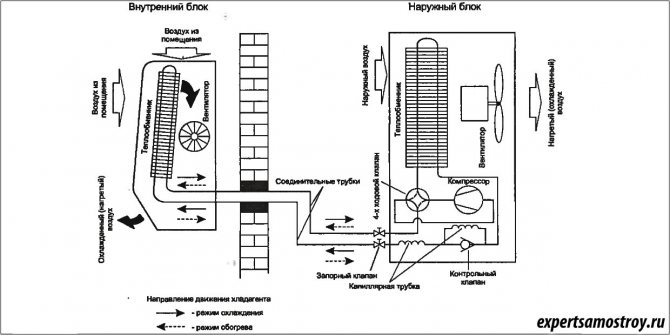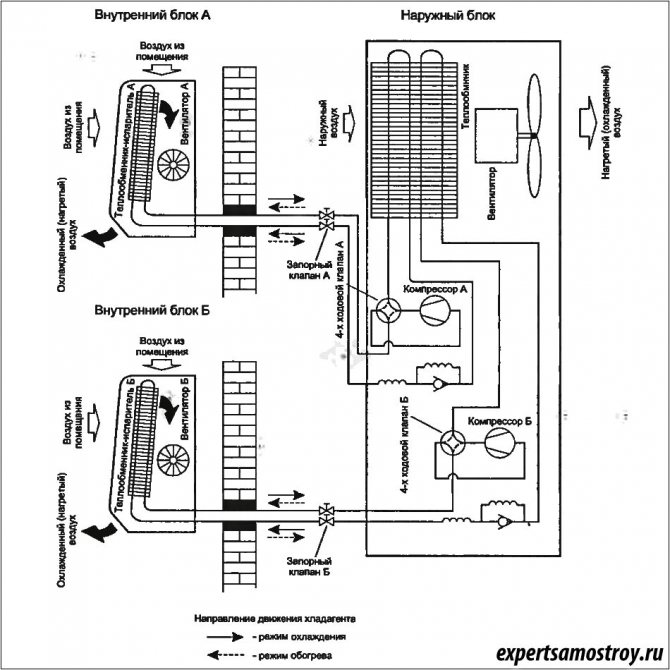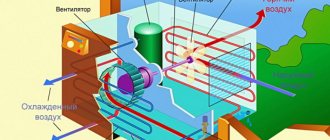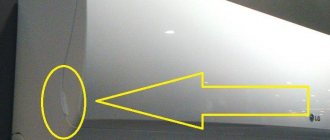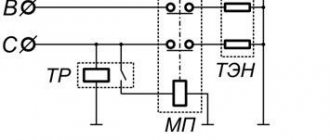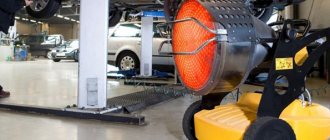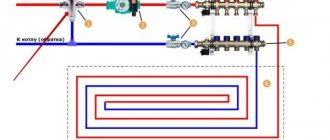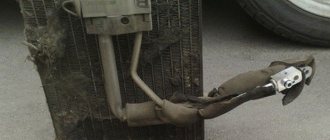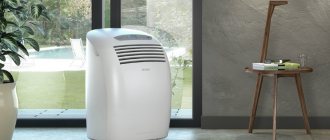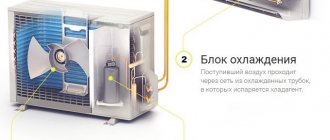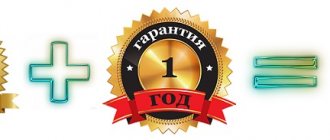Modern split systems can be effectively used not only to save oneself from the summer heat, but also to create a comfortable microclimate in an apartment in winter, if necessary. However, including it in the cold season, a number of important nuances should be taken into account - this will ensure the safe and reliable operation of the device.
Illiterate use of split systems in the winter season entails a quick failure of the equipment. First of all, the drainage system and the compressor are affected. For this reason, extreme care and attention must be given to the performance characteristics on the device.
Operation of the device for space heating
The advantage of using the device for heating a house in the autumn and spring is its economy: to heat a room by 3 kW at an ambient temperature of + 5 ° C, a standard type air conditioner will consume no more than 1 kW of power consumption.
However, despite this, it is highly undesirable to systematically use the device as the main source of heating, since climatic technology at subzero ambient temperatures has low efficiency due to the compression of the Carnot cycle.
To maintain an optimal temperature regime in the house, in addition to an air conditioner, you should purchase heating radiators.
Characteristics and features of the use of a split system in winter
- In cold weather (up to -45 ° C), the viscosity of the oil in the compressor increases, and at -70 ° C it thickens.
- In wall-mounted split systems of low power, the capacity of the oil bath, in comparison with high-performance models, is increased several times, providing reliable protection against de-oiling of the compressor.
- Remember, the main danger of using the air conditioner at low temperatures is the freezing of a layer of ice in the outer block. Often, this malfunction appears as a result of mechanical damage to the fan.
In order to avoid its appearance, it is necessary to give preference to those devices that are equipped with a defrosting function.
- High power split systems are additionally equipped with a crankcase heater.
- When you turn on the device for heating, initially it is necessary to switch it to cooling mode for 3-5 minutes, in order to supply heat to the outdoor unit to melt frost and ice. Only after completing this procedure can the unit be installed to heat the room.
- The indoor unit of the air conditioner should be cleaned at least once a month.
- In the event of extraneous sounds, deterioration of air heating, the growth of an ice "coat" during the operation of the device, it is necessary to turn it off and call the master.
- Once a year, you need to call the foreman to carry out maintenance work. Namely, checking the correct functioning of the unit in different modes, cleaning the indoor and outdoor units from dust, poplar fluff, determining the pressure in the system, identifying hidden faults, refueling freon.
The outdoor unit of the climatic equipment is cleaned by blowing the unit with a jet of compressed air using a special compressor.
The device should be checked for operability before the beginning of the winter period, preferably in the fall. To do this, turn on the unit for 1-2 hours in heating mode.
During the operation of the air conditioner, it is important to make sure that the heated air flow from the indoor unit enters the house.
Remember, if a problem is found, you should contact the service center for help or try to diagnose the breakdown yourself.
To do this, it is necessary to study the structure of the device, as well as familiarize yourself with the main problems and the reasons for their occurrence, which most often arise as a result of the operation of the product.
You should not delay the repair of the device before the onset of cold weather, since during this period, almost all service departments are overloaded with work.
Air conditioner operation in winter in cooling mode
Room cooling using a split system is permissible only if the outside temperature is not lower than + 16 ° C or meets other permissible values specified in the equipment operating manual. In all other cases, turning on the air conditioner in order to lower the temperature in the room is prohibited and threatens with ice formation and water leakage from the indoor unit.
In the photo: Ice formation and water leakage from the indoor unit.
If there is a need to maintain a low temperature even in winter, then it is better to install a special system capable of operating at wider temperature values.
Another option is to modify the air conditioner with a special winter kit, which will provide great opportunities for operating the device in cold weather.
Heating does not turn on: what to do
Why does a modern air conditioner not work for heat? There are three options:
- Incorrect procedure when switching to heating mode.
- The heating function is not provided by the manufacturer.
- The air conditioner is out of order.
If, when changing modes, the "sun" icon or the inscription "HEAT" is not displayed, then your device does not have a heating function. If you have done all the above operations, an indication is displayed on the indoor unit confirming the mode change, and the air conditioner after 30 minutes. work does not turn on for heating, this indicates a malfunction of the device and the need to contact a service center. The most common problem is the lack of refrigerant necessary for the system to function. In addition, the failure of the device to work for heating can occur for the following reasons:
- Dirty filter elements. Cleaning and replacement of filters is required.
- There is a problem with the power supply of the remote control. The batteries need to be replaced.
- Failure in the mains supply. De-energize the device for 60 minutes to reset the settings, then reconnect and carry out the parameter setting procedure.
In some cases, when the air conditioner operates "for warmth", the fan in the indoor unit stops. This is not a malfunction or malfunction. When operating in this mode, condensate forms on the surface of the condensation heat exchanger, which can turn into ice at freezing temperatures outside.
Helpful! The fan regulates the condensation temperature of the freon in the circuit. While it is not working, the temperature of the refrigerant rises, and, consequently, the temperature of the heat exchanger. This process prevents the radiator from freezing.
Preparing the air conditioner for winter
As part of preparing the device for the winter season, a number of preventive measures must be taken.
It is necessary to dry the indoor unit from the accumulated condensation. To do this, the air conditioner must first be turned on for a while for cooling, and then started for heating for the same period. Clean built-in filters from accumulated saw and dirt. If conditions permit, install a protective cover on the outdoor unit.
If there is a standard household air conditioner in the room, then it is better to limit it to turning it on in heating mode only during the off-season - until the temperature drops below the limit values set by the manufacturer.
Additional modes
The main modes listed in the table are available for all air conditioners. They provide minimal comfort.
Now let's talk about the options that make each air conditioner unique in its own way, and how to use the air conditioner in additional modes.
Choose the ones you like, and the consultant of the HVAC store will suggest a suitable split model.
"Ionization". Turning on the mode implies saturation of the room with negatively charged ions (anions). On average, an air conditioner produces up to 20,000 of them per square centimeter. This amount of anions is found only in ecologically clean places. Anions have an antibacterial effect. The ionization function can be considered as an additional fine filter.
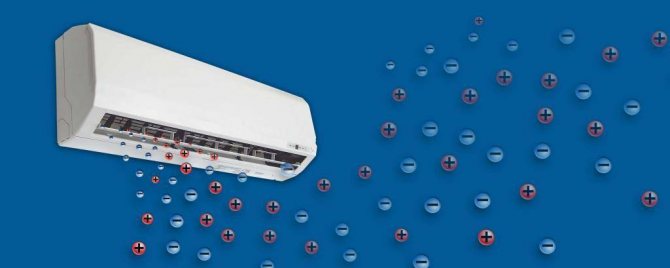
- Self-cleaning. With this function, mold will never develop in the air conditioner. The process lasts about half an hour: the blinds are closed, and the indoor unit is purged, all moisture is removed, the heat exchanger heats up, dries, the air conditioner switches to FAN mode ("Ventilation"), and the air entering the air conditioner carries away all unpleasant odors.
- "Oxygen generator". Air enrichment with oxygen, based on the uneven passage of gases through a polymer membrane.
- "Additional filtration mode". Many models have additional filtration systems. For example, LG brought a plasma filter to the Russian market, and Samsung brought a biological purification filter. Almost every brand has models with multi-stage filtration. A very useful option.
- Fresh air supply. The function in systems with wall units is rather advertising. A very small cross-section of the tube through which air must enter the room. If this function is available, then it is used in air conditioners with multi-stage filters.
- "Night mode" ("Sleep mode"). The transition of the air conditioner to the optimal mode for sleeping. The fan turns on in low noise mode. That is, its rotation speed decreases. In addition, when the air conditioner is operating in cooling mode, the temperature rises by 1-3 degrees for several hours. And when working in heating mode, it goes down for several hours.


- "Timer". Allows you to turn on the air conditioner at a certain hour (for example, at the time of coming to work) and turn it off at a certain time.
- Forced cooling or heating. In some models, the mode may be called TURBO, in others - JET COOL. The essence is the same - for half an hour (after pressing the corresponding button) the air conditioner operates at the minimum temperature at the maximum possible fan speed. It is used for rapid cooling of a room.
- I FEEL. In this mode, the temperature is measured not by the indoor unit sensor, but by the remote control sensor. The most comfortable conditions are created in the place where the control panel is located, i.e. next to the person.
- "Smart Eye". I SEE - volumetric temperature scan sensor. Monitors temperature and humidity throughout the room. The air conditioner receives information and adjusts the temperature by zones. I SEE prevents sudden temperature changes by synchronizing the operation of the fan and shutters.
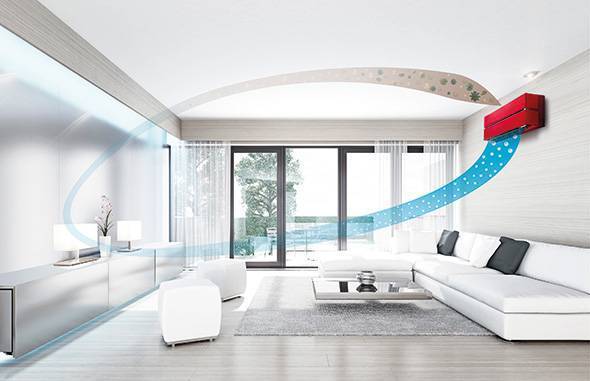

Air conditioner device
The best way to understand how the system works is by familiarizing yourself with the individual components of the device. The split system consists of two components - internal and external, which cannot exist without each other and are interconnected.
The outer part of the air conditioner
The outdoor unit is installed from the street side and is designed to cool hot freon. It consists of the following elements:
- the fan creates air currents blown by the condenser;
- Condenser is a component, cooling and conditioning refrigerant. The air passing through it is heated and discharged outside;
- the compressor is one of the main components of the system, which is responsible for the compression and circulation of the coolant through the refrigeration circuits;
- the control unit can be located both in the outer and in the inner part of the device, depending on the model;
- four-way valve - a mechanism that allows switching between cooling and heating modes. With its help, the direction of freon and the principles of operation of the indoor and outdoor units change;
- a coolant filter is located in front of the compressor to protect the case from debris and dust from entering the system;
- various fittings - parts designed to connect copper pipes between the inner and outer components;
- the protective panel provides reliable protection of the case from damage and penetration.
Indoor unit
It is located inside the room, its structure is in many ways similar to the design of the external one, but it has its own design features:
- the front panel is made of durable plastic and is designed to allow air flow into the room. It is easy to remove and install back to clean or replace filters;
- a coarse filter is a plastic mesh that can hold large debris, animal hair, and more. It needs to be cleaned every month;
- fine filters - a whole system of filter elements, consisting of carbon, antibacterial, electrostatic and other cleaning units. Depending on the model of the unit, the kit may include only individual components or all at once;
- cooler - a fan circulating air in a room, both cold and heated;
- the evaporator is an obligatory element of the system, which is responsible for cooling freon;
- blinds - an external component designed to adjust the direction of flow;
- panel with indicators - a small display showing the operating mode of the device, possible error codes, on some models also shows the current temperature and time;
- control board - the electronic unit and the central processor are located on the part.
Interesting! Most often, air conditioning equipment operates on a two-unit system. Two units are needed to simultaneously generate cold and remove heat to the outside. A rarer option is single-block installations that remove heat to the street through a special air duct.
The principle of operation of the equipment
Heating operation takes place according to the reverse cooling scheme and becomes possible due to the unique properties of the refrigerant. Technology stages
- Freon comes from the indoor unit in a liquid state to the outdoor one.
- Outside the building, it gains heat and evaporates. This becomes possible due to its low boiling point (-50 ... -40 C), which is often lower than the frost outside.
- The refrigerant enters the compressor, where it is compressed and, due to the increase in pressure, heats up to + 70 ... + 90 C. In this form, it returns to the indoor module.
- There it passes through the channels of the radiator and gives off heat to the surrounding space. The direction of movement of the heated air flows is given by the fan. As the energy is lost, freon turns into a liquid state, a new cycle begins.
This principle of operation allows the equipment to be classified as heat pumps that “pump out” the resource from the surrounding space.
Refinement of the split system for winter operation
The winter kit for the air conditioner is equipped with devices that prevent the refrigerant from overcooling, provide heating of the drain line and keep the oil in a liquefied state.
The principle of its operation is as follows:
- a crankcase heater heats up the oil in the compressor, which carries the main load at start-up, especially in winter; a device for heating the drainage system, both inside and outside, allows condensate to freely escape through the drainage pipe, preventing the formation of an ice plug;
- the temperature sensor detects in time their decrease in the street and slows down the fan on the external unit of the device, due to which ice does not form in it, and along the way, problems with the reduced performance of the split system are solved.
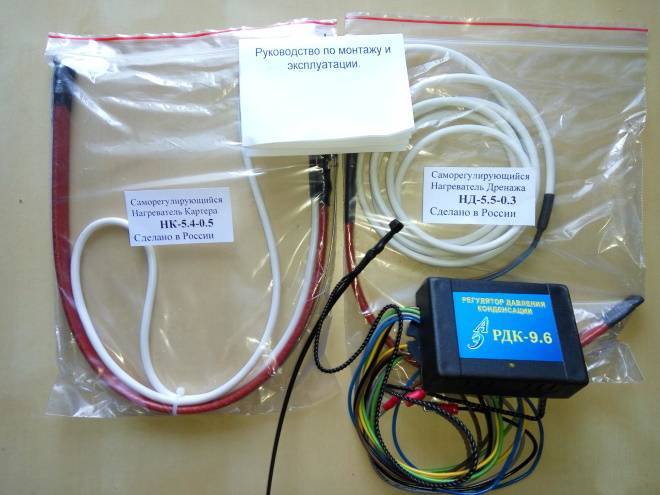

The winter kit is installed once and then performs its functions automatically - it is triggered when it gets cold. Now the information about the temperature to which the air conditioner can be turned on, written in the manual for the device, can be neglected, because the winter kit significantly expands its capabilities - on average, up to -15 ° С, and in the absence of strong winds up to -20 ° С. The temperature range can be increased further, although this is usually not an economically viable measure.
The operation of the air conditioner, improved with the winter kit, is permissible at a lower temperature threshold, however, this is only true for the cooling mode! When heated, everything will remain unchanged, moreover, there will be a risk of water hammer.
In addition, a low temperature air conditioner kit can sometimes cost more than the unit itself. It is cheaper and easier to install it immediately when installing a split system. It is worth remembering that the equipment warranty will only apply if it was installed by service center specialists, and not by the owner on his own.
What is a winter kit and what is it for
The winter kit is a set of special devices that ensure the safe operation of the air conditioner at temperatures below the range specified by the manufacturer. It includes crankcase heating, drain heating, fan speed controller. With the help of these devices, icing of the drainage system, the formation of ice on the body, thickening of the oil and overcooling of freon are prevented.
In the photo: Winter kit for Dantex air conditioner
But when using a winter kit, it is very important not to forget that air conditioners equipped with it can only work for cooling. Heating in this case is possible only within the temperature range indicated in the technical specifications of the device.
The advantages and disadvantages of such heating
Air conditioners and split systems, providing for the possibility of heating a room, have their own advantages and disadvantages. After careful analysis of real user reviews, the main aspects were highlighted in the following table.
| pros | Minuses |
| High efficiency. | High price of split systems with heating mode. |
| Rapid air heating. | A complex device. |
| Low energy consumption compared to heaters, since electricity is not spent on generating heat, but only on transferring it. | The need to use a winter kit. |
| More even distribution of heat in the room compared to stationary heaters. | To avoid lubrication downtime, the air conditioner must be switched on periodically. |
| Since air conditioners do not have a heating element (such as heating elements), they practically do not burn air in the room and do not emit carbon monoxide. | When installing equipment operating on the principle of heat pumps, careful and complex design is necessary, otherwise separate cold zones may appear in the room, and condensation will settle on the glass. |
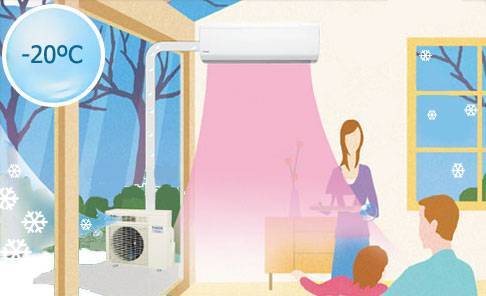

Heating air conditioner design
The principle of operation of the device is based on the properties of liquids: during evaporation, water absorbs heat, and during condensation, it releases.
In modern models of air conditioners, freon (refrigerant) acts as this substance, its freezing point is 100 ° C, and its boiling point is 80 ° C.
Consider the device of climatic technology
- Compressor - this is the "heart" of the device, it is designed to ensure the movement of refrigerant in the refrigeration circuit.
- Fans, are responsible for creating an air flow, which in turn serves to blow off the condenser with the evaporator.
- Capacitor, provides condensation of the refrigerant from a gaseous state to a liquid state.
- Tthermostatic expansion valve, serves to reduce the pressure of the refrigerant in front of the evaporator.
- Corrector, designed to convert a liquid refrigerant into a gaseous state.
As a rule, most air conditioning devices work to cool the air in the house, but if it is necessary to warm it up, the device operates in the “opposite direction”.
Namely, the refrigerant in the gaseous state is pumped into the condenser, then the process of its condensation takes place, followed by the release of heat. After that, the heated air is supplied to the living room with the help of fans.
Control command thermostat
What it is? The thermostat is a special device designed to constantly maintain the set air temperature. This function is carried out by thermostats. It is used in many devices, for example, in a car air conditioner.
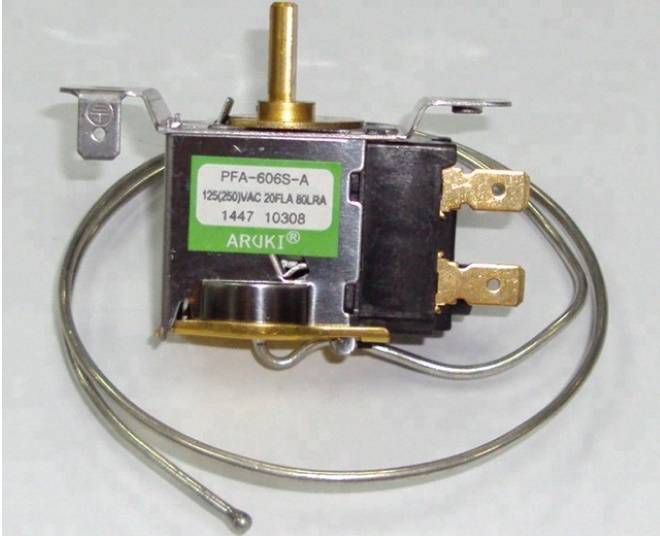

This device plays a special role in the air conditioner. It allows you to effectively control the air temperature, quickly adjusting the required characteristics. The thermostat is located next to the air conditioner. For proper operation, no specialized procedures are needed, this can be done independently - it is recommended to constantly maintain the cleanliness and dryness of the mechanism.
How to turn on the air conditioner without using the remote control
Everyone periodically loses the remote control from the TV, especially if there are small children in the house. And if the search is unsuccessful, then you have to do all the manipulations manually. The situation with the remote control from the air conditioner is even worse, because in size it is 2 times smaller than the television one. Therefore, this particular gadget is “hard to find and easy to lose”. And this suggests that manual configuration is indispensable. You need to know how the air conditioner works for heating, and how to set it up in manual mode. We offer a list of actions how to turn on the air conditioner for heating manually:
- The first step is to check the performance of the split system. If the wires are in order and there are no visual disturbances, then you can proceed to the next stage.
- A plastic cover is attached to the front of the air conditioner. It is rectangular and small in size. It is required to slightly press on the cover and, grasping it from both sides, slowly lift it.
- There is a button under the cover. It can be on the left or right side. When the device is turned on, it will glow either green or orange.
- If the air conditioner needs to be turned on or off, then the button must be pressed and held for 3-4 seconds.
- But if it is necessary to make a switch - change the cooling mode to a heater or vice versa, then the button does not need to be held down. Press and release sharply.
The downside is that air conditioners are set high enough and it is not always possible to “conquer the heights of space”, and the temperature cannot be changed manually, for this you need a remote control. If the remote control simply breaks down or is lost so that it is impossible to find it, then you can buy a new one, but before you go and buy a new gadget, do not forget to look at the model and brand of the split system.
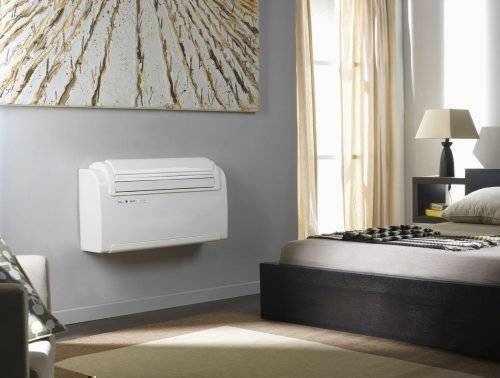

The remote control is easily lost, and there is a need for manual control of the device
Features and principle of operation of the split system for heat
Any split system is not a heating device, it does not have a heating element, therefore, there will be little climate control system to maintain a comfortable temperature. This is due to the peculiarities of the principles of its functioning.The air conditioner operates in heating mode only at certain outdoor thermometer values.
Most splits can produce warm air. In general terms, this process can be called the reverse of freon, in which the compressor is responsible for pumping it towards the room: heat is taken from the outside and carried inside. Changing the refrigerant stroke requires a four-way valve that swaps the evaporator and condenser positions. Freon condensation occurs in the indoor unit with the release of heat, and in the external unit, evaporation occurs, during which the air conditioner absorbs heat. Heat is pumped from one place to another, but not generated. Because of this, in heating mode, the efficiency of the air conditioner is greatly reduced, which makes it ineffective at street temperatures closer to zero marks.
Outside Temperature Range Limitations
The majority of air conditioners with a heating function have certain limitations: manufacturers produce climatic equipment with a programmed ability to work on heat at a minimum outside temperature of up to -5 ° C. In practice, it has been proven: with minus indicators, the split system should not be started. It can be concluded that it is impossible to use an air conditioner for heating in winter. At best, it will be possible to warm up in this way until November.
Failure to comply with the recommendations given in the instructions and during installation leads to wear and tear in a constant start-stop mode. Modern two-component devices have a special program in which a signal is given from the temperature sensor to the board about the unacceptable temperature values of the heat exchanger, and the device is blocked. In extreme cases, only the fan will work, or one of the error codes will be displayed - each brand has its own codes.
How to turn on and adjust the air conditioner for warm air
If the outdoor temperature is correct, turn on the air conditioner using the ON button on the remote control or on the external panel.
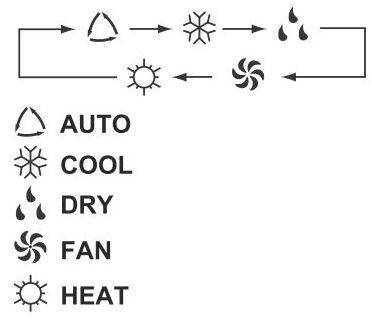

Find the HEAT button, or MODE and then the icon with the image of the sun, drop, snow or fan. If there is nothing like this, then this model of the air conditioner is not intended for heating the room.
After switching the system to thermal mode, use the “+” and “-” buttons to set the required temperature. It should be higher than the room temperature.
After setting the desired temperature, the fan will turn on, and then warm air will begin to flow. The preset climate will be established within 10 minutes.
There are models in which you first need to set the mode and temperature, and then press the ON button. Detailed instructions are attached to the device upon purchase.
What systems can work in heating mode in winter
There are equipment on the modern market that can be safely turned on in winter in heating mode - even when the temperature drops to -15 ° C ... -30 ° C. These are inverter-type split systems. They are distinguished from standard air conditioners by the presence of an inverter compressor, which provides capacity control. The use of an inverter compressor with EVI refrigerant vapor injection and a receiver allows for stable operation at very low ambient temperatures - some models are designed for operation at -30 ° C.

